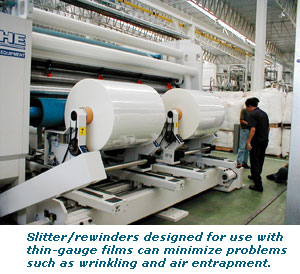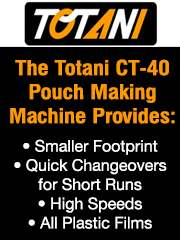Going Thin
- Published: June 30, 2007, By By Keith Fordham Ashe Converting Equipment
July Web Exclusive
There is a strong economic incentive to make webs as light and thin as possible providing, of course, performance properties are not sacrificed. To begin with, raw material costs are contained. Other incentives for going thin are that the material takes up less storage space, handling is made easier, and transport costs can be reduced.
Thinner gauge materials impact both on operating costs and the environment. Theoretically, less energy and material is needed to make these materials, and when it comes to waste, less goes to the landfill.
The difficulty with going thin is that problems such as wrinkling, air entrapment, and tension control, and various other problems typically associated with material profile perturbations, such as gauge band variations, can become magnified when processed on some types of slitter/rewinders and other converting machinery.
Defects such as calliper ridges can occur on winders, and if the ridges are very pronounced, the risk of blocking becomes greater. Also, if the winder is presented with variations in calliper, the web can become stretched and baggy over gauge band variations. Surface winders, particularly those that bear the weight of the roll on a drum, such as the two-drum winder, are particularly intolerant to calliper or weight variations.
Thin webs are prone to wrinkling and creasing; they have a higher relative non-uniformity and are more inclined to be affected by heat/moisture and solvents. Thin materials also are more demanding in terms of mechanical maintenance. Thicker materials are unfazed by the grooves on a roller or slight roller misalignment, but this is not always the case when running super thin films and other thinner gauge products. Consequently the OEM manufacturer must consider these factors and manufacture to close tolerances.
Careful control of tension is critical at any time; it’s absolutely vital when running thin materials. A general guide for many web materials is that tension should be between 10% and 25% of machine directional tensile strength. However, for very light materials, the tension may need to be kept within a control envelope of between 5% and 10% tensile strength.
For optimum control, closed loop methods of tension control are a good option. The term closed loop comes from the fact that the output of the system (tension) is fed back into the input. This enables us to visualize the output forming a continuous path through the regulator and back to the input, circulating endlessly in an unbroken loop.

When it comes to slitters and rewinders, constant unwind tension is critical to ensure good slitting and tracking. Closed loop control provides the stability needed so the rewinder is able to rewind narrow rolls accurately, avoiding core crushing and telescoping of finished rolls.
Control of the in-feed is equally important. Developments have been made that are designed to facilitate the passing of material such as thin films through this zone without creasing due to web slackness.
Careful control of tension also is necessary to ensure that the web guide is able to steer the web into the slitter knives, giving the knives a chance to perform as designed and to ensure clean cut edges and a well rounded finished roll.
Manufacturers of converting equipment can do much to minimize many of the problems that arise during processing by paying close attention to various aspects of machine design and manufacture. By listening to the needs of prospective customers and taking note of material developments and market trends, a new breed of innovative machines, able to accommodate a wide range of materials, is becoming available.
Keith Fordham is chief engineer for Ashe Converting Equipment. Ipswich, UK. Contact him at sales@ashe.co.ul.
SUPPLIER INFO:
Ashe Converting Equipment—ashe.co.uk












